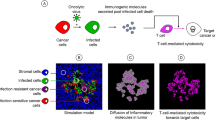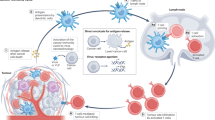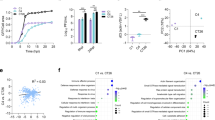Abstract
Optimization of oncolytic viruses for therapeutic applications requires the strategic removal or mutagenesis of virulence genes alongside the insertion of transgenes that enhance viral replication, spread and immunogenicity. However, the complexity of many viral genomes and the labour-intensive nature of methods for the generation and isolation of recombinant viruses have hindered the development of therapeutic oncolytic viruses. Here we report an iterative strategy that exploits the preferential susceptibility of viruses to certain antibiotics to accelerate the engineering of the genomes of oncolytic viruses for the insertion of immunomodulatory cytokine transgenes, and the identification of dispensable genes with regard to replication of the recombinant oncolytic viruses in tumour cells. We applied the strategy by leveraging insertional mutagenesis via the Sleeping Beauty transposon system, combined with long-read nanopore sequencing, to generate libraries of herpes simplex virus type 1 and vaccinia virus, identifying stable transgene insertion sites and gene deletions that enhance the safety and efficacy of the viruses.
This is a preview of subscription content, access via your institution
Access options
Access Nature and 54 other Nature Portfolio journals
Get Nature+, our best-value online-access subscription
$32.99 / 30 days
cancel any time
Subscribe to this journal
Receive 12 digital issues and online access to articles
$119.00 per year
only $9.92 per issue
Buy this article
- Purchase on SpringerLink
- Instant access to full article PDF
Prices may be subject to local taxes which are calculated during checkout






Similar content being viewed by others
Data availability
The data supporting the results in this study are available within the paper and its Supplementary Information. The raw and analysed long-read sequencing datasets generated during the study are too large to be publicly shared, but are available for research purposes from the corresponding authors upon reasonable request. Source data are provided with this paper.
References
Kelly, E. & Russell, S. J. History of oncolytic viruses: genesis to genetic engineering. Mol. Ther. 15, 651–659 (2007).
Lemos de Matos, A., Franco, L. S. & McFadden, G. Oncolytic viruses and the immune system: the dynamic duo. Mol. Ther. Methods Clin. Dev. 17, 349–358 (2020).
Xu, L., Sun, H., Lemoine, N. R., Xuan, Y. & Wang, P. Oncolytic vaccinia virus and cancer immunotherapy. Front. Immunol. 14, 1324744 (2023).
Pelin, A., Boulton, S., Tamming, L. A., Bell, J. C. & Singaravelu, R. Engineering vaccinia virus as an immunotherapeutic battleship to overcome tumor heterogeneity. Expert Opin. Biol. Ther. 20, 1083–1097 (2020).
De Graaf, J. F., de Vor, L., Fouchier, R. A. M. & van den Hoogen, B. G. Armed oncolytic viruses: a kick-start for anti-tumor immunity. Cytokine Growth Factor Rev. 41, 28–39 (2018).
Lin, D., Shen, Y. & Liang, T. Oncolytic virotherapy: basic principles, recent advances and future directions. Signal Transduct. Target. Ther. 8, 156 (2023).
Parato, K. A., Lichty, B. D. & Bell, J. C. Diplomatic immunity: turning a foe into an ally. Curr. Opin. Mol. Ther. 11, 13–21 (2009).
Roizman, B. & Jenkins, F. J. Genetic engineering of novel genomes of large DNA viruses. Science 229, 1208–1214 (1985).
Greseth, M. D. & Traktman, P. The life cycle of the vaccinia virus genome. Annu. Rev. Virol. 9, 239–259 (2022).
Peters, C. & Rabkin, S. D. Designing herpes viruses as oncolytics. Mol. Ther. Oncolytics 2, 15010 (2015).
Blasco, R. & Moss, B. Selection of recombinant vaccinia viruses on the basis of plaque formation. Gene 158, 157–162 (1995).
Gowripalan, A., Smith, S., Stefanovic, T. & Tscharke, D. C. Rapid poxvirus engineering using CRISPR/Cas9 as a selection tool. Commun. Biol. 3, 643 (2020).
Velusamy, T., Gowripalan, A. & Tscharke, D. C. CRISPR/Cas9-based genome editing of HSV. Methods Mol. Biol. 2060, 169–183 (2020).
Whelan, J. T. et al. CRISPR-mediated rapid arming of poxvirus vectors enables facile generation of the novel immunotherapeutic STINGPOX. Front. Immunol. 13, 1050250 (2023).
Liao, Y., Bajwa, K., Reddy, S. M. & Lupiani, B. Methods for the manipulation of herpesvirus genome and the application to Marek’s disease virus research. Microorganisms 9, 1260 (2021).
Yao, X. D. & Evans, D. H. Effects of DNA structure and homology length on vaccinia virus recombination. J. Virol. 75, 6923–6932 (2001).
Walsh, D., Mathews, M. B. & Mohr, I. Tinkering with translation: protein synthesis in virus-infected cells. Cold Spring Harb. Perspect. Biol. 5, a012351 (2013).
Katze, M. G., He, Y. & Gale, M. Jr. Viruses and interferon: a fight for supremacy. Nat. Rev. Immunol. 2, 675–687 (2002).
Dhungel, P., Cantu, F. M., Molina, J. A. & Yang, Z. Vaccinia virus as a master of host shutoff induction: targeting processes of the central dogma and beyond. Pathogens 9, 400 (2020).
Serio, A. W., Keepers, T., Andrews, L. & Krause, K. M. Aminoglycoside revival: review of a historically important class of antimicrobials undergoing rejuvenation. EcoSal Plus 8, 1–20 (2018).
Guo, C., Fordjour, F. K., Tsai, S. J., Morrell, J. C. & Gould, S. J. Choice of selectable marker affects recombinant protein expression in cells and exosomes. J. Biol. Chem. 297, 100838 (2021).
Aviner, R. The science of puromycin: from studies of ribosome function to applications in biotechnology. Comput. Struct. Biotechnol. J. 18, 1074–1083 (2020).
Kaster, K. R., Burgett, S. G., Rao, R. N. & Ingolia, T. D. Analysis of a bacterial hygromycin B resistance gene by transcriptional and translational fusions and by DNA sequencing. Nucleic Acids Res. 11, 6895–6911 (1983).
Powers, K. T. et al. Blasticidin S inhibits mammalian translation and enhances production of protein encoded by nonsense mRNA. Nucleic Acids Res. 49, 7665–7679 (2021).
Ilkow, C. S., Swift, S. L., Bell, J. C. & Diallo, J.-S. From scourge to cure: tumour-selective viral pathogenesis as a new strategy against cancer. PLoS Pathog. 10, e1003836 (2014).
Dogrammatzis, C., Waisner, H. & Kalamvoki, M. “Non-essential” proteins of HSV-1 with essential roles in vivo: a comprehensive review. Viruses 13, 17 (2020).
Izsvák, Z. & Ivics, Z. Sleeping Beauty transposition: biology and applications for molecular therapy. Mol. Ther. 9, 147–156 (2004).
Azad, T. et al. Synthetic virology approaches to improve the safety and efficacy of oncolytic virus therapies. Nat. Commun. 14, 3035 (2023).
Wang, Y., Zhao, Y., Bollas, A., Wang, Y. & Au, K. F. Nanopore sequencing technology, bioinformatics and applications. Nat. Biotechnol. 39, 1348–1365 (2021).
Al Ali, S., Baldanta, S., Fernández-Escobar, M. & Guerra, S. Use of reporter genes in the generation of vaccinia virus-derived vectors. Viruses 8, 134 (2016).
Lee, M. S. et al. Molecular attenuation of vaccinia virus: mutant generation and animal characterization. J. Virol. 66, 2617–2630 (1992).
Palanivelu, L., Liu, C.-H. & Lin, L.-T. Immunogenic cell death: the cornerstone of oncolytic viro-immunotherapy. Front. Immunol. 13, 1038226 (2023).
Krabbe, T. & Altomonte, J. Fusogenic viruses in oncolytic immunotherapy. Cancers (Basel) 10, 216 (2018).
Fucikova, J. et al. Detection of immunogenic cell death and its relevance for cancer therapy. Cell Death Dis. 11, 1013 (2020).
Todo, T., Martuza, R. L., Rabkin, S. D. & Johnson, P. A. Oncolytic herpes simplex virus vector with enhanced MHC class I presentation and tumor cell killing. Proc. Natl Acad. Sci. USA 98, 6396–6401 (2001).
Kanai, R. et al. Effect of γ34.5 deletions on oncolytic herpes simplex virus activity in brain tumors. J. Virol. 86, 4420–4431 (2012).
Wilcox, D. R. & Longnecker, R. The herpes simplex virus neurovirulence factor γ34.5: revealing virus–host interactions. PLoS Pathog. 12, e1005449 (2016).
Chou, J., Kern, E. R., Whitley, R. J. & Roizman, B. Mapping of herpes simplex virus-1 neurovirulence to γ134.5, a gene nonessential for growth in culture. Science 250, 1262–1266 (1990).
Chu, V. T. et al. Increasing the efficiency of homology-directed repair for CRISPR–Cas9-induced precise gene editing in mammalian cells. Nat. Biotechnol. 33, 543–548 (2015).
Tang, N., Zhang, Y., Shen, Z., Yao, Y. & Nair, V. Application of CRISPR–Cas9 editing for virus engineering and the development of recombinant viral vaccines. CRISPR J. 4, 477–490 (2021).
Balliet, J. W., Kushnir, A. S. & Schaffer, P. A. Construction and characterization of a herpes simplex virus type I recombinant expressing green fluorescent protein: acute phase replication and reactivation in mice. Virology 361, 372–383 (2007).
Propper, D. J. & Balkwill, F. R. Harnessing cytokines and chemokines for cancer therapy. Nat. Rev. Clin. Oncol. 19, 237–253 (2022).
Chon, H. J. et al. Tumor microenvironment remodeling by intratumoral oncolytic vaccinia virus enhances the efficacy of immune-checkpoint blockade. Clin. Cancer Res. 25, 1612–1623 (2019).
Nakao, S. et al. Intratumoral expression of IL-7 and IL-12 using an oncolytic virus increases systemic sensitivity to immune checkpoint blockade. Sci. Transl. Med. 12, eaax7992 (2020).
Rozman, B., Fisher, T. & Stern-Ginossar, N. Translation—a tug of war during viral infection. Mol. Cell 83, 481–495 (2023).
Stern-Ginossar, N., Thompson, S. R., Mathews, M. B. & Mohr, I. Translational control in virus-infected cells. Cold Spring Harb. Perspect. Biol. 11, a033001 (2019).
Upton, C., Slack, S., Hunter, A. L., Ehlers, A. & Roper, R. L. Poxvirus orthologous clusters: toward defining the minimum essential poxvirus genome. J. Virol. 77, 7590–7600 (2003).
Kambara, H., Okano, H., Chiocca, E. A. & Saeki, Y. An oncolytic HSV-1 mutant expressing ICP34.5 under control of a nestin promoter increases survival of animals even when symptomatic from a brain tumor. Cancer Res. 65, 2832–2839 (2005).
Wang, L., Chard Dunmall, L. S., Cheng, Z. & Wang, Y. Remodeling the tumor microenvironment by oncolytic viruses: beyond oncolysis of tumor cells for cancer treatment. J. Immunother. Cancer 10, e004167 (2022).
Robert, C. A decade of immune-checkpoint inhibitors in cancer therapy. Nat. Commun. 11, 3801 (2020).
Hwang, J. K., Hong, J. & Yun, C.-O. Oncolytic viruses and immune checkpoint inhibitors: preclinical developments to clinical trials. Int. J. Mol. Sci. 21, 8627 (2020).
Huehls, A. M., Coupet, T. A. & Sentman, C. L. Bispecific T-cell engagers for cancer immunotherapy. Immunol. Cell Biol. 93, 290–296 (2015).
Heidbuechel, J. P. W. & Engeland, C. E. Oncolytic viruses encoding bispecific T cell engagers: a blueprint for emerging immunovirotherapies. J. Hematol. Oncol. 14, 63 (2021).
Whatcott, C. J., Han, H., Posner, R. G., Hostetter, G. & Von Hoff, D. D. Targeting the tumor microenvironment in cancer: why hyaluronidase deserves a second look. Cancer Discov. 1, 291–296 (2011).
Hong, S.-O. et al. Transgenic viral expression of PH-20, IL-12, and sPD1-Fc enhances immune cell infiltration and anti-tumor efficacy of an oncolytic virus. Mol. Ther. Oncolytics 30, 301–315 (2023).
Moaven, O., Mangieri, C. W., Stauffer, J. A., Anastasiadis, P. Z. & Borad, M. J. Strategies to develop potent oncolytic viruses and enhance their therapeutic efficacy. JCO Precis. Oncol. 5, PO.21.00003 (2021).
Aitken, A. S. et al. Brief communication; a heterologous oncolytic bacteria-virus prime-boost approach for anticancer vaccination in mice. J. Immunother. 41, 125–129 (2018).
Martin, N. T. & Bell, J. C. Oncolytic virus combination therapy: killing one bird with two stones. Mol. Ther. 26, 1414–1422 (2018).
Bridle, B. W. et al. Vesicular stomatitis virus as a novel cancer vaccine vector to prime antitumor immunity amenable to rapid boosting with adenovirus. Mol. Ther. 17, 1814–1821 (2009).
Pol, J. G. et al. Development and applications of oncolytic Maraba virus vaccines. Oncolytic Virother. 7, 117–128 (2018).
Sapkota, B. et al. Heterologous prime-boost strategies for COVID-19 vaccines. J. Travel Med. 29, taab191 (2022).
Acknowledgements
We thank other members of the J.C.B. and T. Azad laboratories for contributing to this work. We also acknowledge the support of the personnel from the Flow Cytometry Core Facility, Histology Core Facility and Animal Care and Veterinary Services of the Faculty of Medicine at the University of Ottawa. J.C.B. discloses support from the Canadian Institutes of Health Research (CIHR; grant number 448323), Canadian Cancer Society Research Institute, Prostate Cancer Canada and BioCanRx. T. Azad discloses support from the CIHR (grant number 49634), Terry Fox New Investigator Awards and Cancer Research Society Next Generation of Scientists Award. R.R. discloses support from a Vanier Canada Graduate Scholarship from CIHR. S.B. discloses support from a CIHR Postdoctoral Fellowship (grant number 187898).
Author information
Authors and Affiliations
Contributions
J.C.B. and T. Azad proposed and supervised the project. R.R., S.B., M.A., J. Petryk, N.K.Z., R.S., G.S.-L., L.D., A.P., J. Poutou, A.I.M.Z., C.C., V.H.G., Z.K., B.A., K.A.O., R.M., Z.A., F.M., V.M., E.W., A.N.-A., A.A. and F.P.A. performed the in vitro and in vivo experiments. R.R., T. Azad, S.B. and M.D.S. engineered the viruses. A.S., R.R. and T. Azad designed the figures and illustrations. R.R., T. Azad, R.S., A.S., F.M. and S.B. performed the data analyses. R.R., R.S., T. Azad, A.S. and J.C.B. wrote the manuscript. S.S.G.F., T.C.H., T. Alain, L.-H.T., C.S.I. and J.-S.D. contributed to study design.
Corresponding authors
Ethics declarations
Competing interests
The authors declare no competing interests.
Peer review
Peer review information
Nature Biomedical Engineering thanks Antonio Chiocca, Howard Kaufman and the other, anonymous, reviewer(s) for their contribution to the peer review of this work. Peer reviewer reports are available.
Additional information
Publisher’s note Springer Nature remains neutral with regard to jurisdictional claims in published maps and institutional affiliations.
Supplementary information
Source data
Source Data Figs. 1–6
Source data and unprocessed western blots.
Rights and permissions
Springer Nature or its licensor (e.g. a society or other partner) holds exclusive rights to this article under a publishing agreement with the author(s) or other rightsholder(s); author self-archiving of the accepted manuscript version of this article is solely governed by the terms of such publishing agreement and applicable law.
About this article
Cite this article
Rezaei, R., Boulton, S., Ahmadi, M. et al. Antibiotic-mediated selection of randomly mutagenized and cytokine-expressing oncolytic viruses. Nat. Biomed. Eng 9, 822–835 (2025). https://doi.org/10.1038/s41551-024-01259-7
Received:
Accepted:
Published:
Issue date:
DOI: https://doi.org/10.1038/s41551-024-01259-7
This article is cited by
-
Antibiotic-driven boosting of oncolytic virotherapy
Nature Biomedical Engineering (2024)



